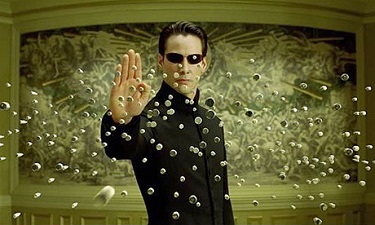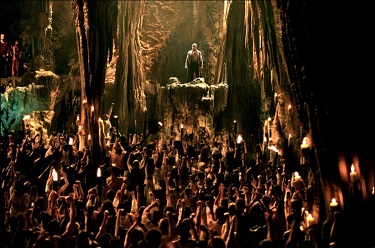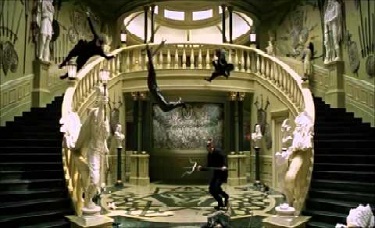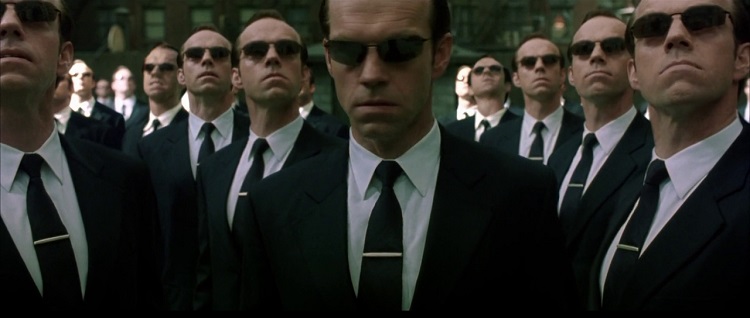From Parable To Reality | The Matrix Reloaded 15 Years On
Sequels are always a tricky prospect, especially to a film that was as much of a pop culture phenomenon as The Matrix. The Wachowski siblings had come, seemingly out of nowhere, with a bold thinker’s action movie; a film that combined the stylish and influential fight choreography of Yuen Woo-Ping with thoughtful metaphors on the nature of consciousness, the dehumanizing nature of corporate labour, and what in retrospect is a fairly obvious metaphor for the self-realisation of a transgender identity. [1] A tough act to follow in many respects, and one which at the time many felt The Matrix Reloaded had fallen far short of. But does that make it a bad movie?

To be fair, the dice were loaded against it from the start. It’s pretty clear that The Matrix was never really intended to have a sequel, and so Reloaded was forced to reverse-engineer a reality from what had originally been metaphorical events. In the original Matrix, for example, the abilities that the hero Neo (Keanu Reeves) shows at the end of the film (stopping bullets with his mind, defeating his nemesis Agent Smith (Hugo Weaving) with one hand, flight) are all intended to demonstrate his transcendence of the false reality of the Matrix. But a hero without any limits would itself fatally limit the type of story you could tell, and so these moments of transcendence instead become constrained new abilities that Neo possesses. And it is almost only those abilities; there are a few additional powers he displays but these are few and far between. At the end of the first film Neo was the god in the machine; now he has become just another superhero.

The transformation of the world of the films into a fully-fleshed out universe does have some high points, though. The main one is the idea of the Matrix being not only home to enslaved humans and sinister Agents, but also “rogue programs”. From the Oracle of the first film to the delightfully sinister ghost twins, these new additions to the lore help to flesh out the world while maintaining some of the strangeness that familiarity robs the world of. Similarly the human city of Zion and the array of other ship’s captains lend the world outside the Matrix a depth it lacked in the original film. This depth was in part due to them being fleshed out in the tie-in videogame Enter The Matrix, which was written and developed in parallel with the film. Shorn of context the appearance of characters from the game could seem haphazard; but the story that it weaves around the narrative of of the film has the additional effect of lending an additional sense of depth, and of a world where things go on beyond what we see.

Not all the worldbuilding is successful though. The film’s plot falls between two stools, as it simultaneously over- and under-explains vital details. The fact that the total human population kept alive by the machines in the Matrix is down to around 25 million, for example, is something that is implied but never spoken. (Though it does then contextualise the singular references given to things inside the Matrix. “The city” is nameless, because there are no other cities to distinguish it from.) Conversely, the significance of the subtle references to Neo’s “predecessors” and the Keymaker’s talk of his “purpose” is lost on many viewers because the payoff is delivered in a dry expository near-monologue towards the end of the film. Popular reaction and mockery showed that the Wachowskis sorely overestimated the ability of the average film-goer to pay attention to this scene. In defense of the audience, the exposition-heavy speeches in the first film were delivered by Laurence Fishburne and Hugo Weaving; two actors who could make reading a phonebook seem compelling. The unfortunate Helmut Bakaitis can’t quite pull off the same effect, and the result is that a scene where he lays out his entire story still left a surprising number of viewers confused.

Some of the initial backlash to the film centred around the “rave” scene in Zion, where dancing Zionites are intercut with a sex scene between Neo and Trinity (Carrie Ann Moss). At the time, this was seen as simple generic trendiness. From the distance of time however, it can be seen as two separate expressions of people crying out their defiance at a cruel and uncaring world, embracing the moment and refusing to recognize the horrors that the future could bring. In that sense, then, it may be one of the most starkly honest sex scenes ever put on screen. It also acts as an embrace of the physical and the sensual, a rebuttal to all those who said after the first film: “Wouldn’t life be better inside the Matrix?” Reality may be grim and sordid in places, but as this scene shows it’s also a place where people can truly live rather than go through a pale imitation of it.

Looking at the film with modern eyes, it’s enlightening to see what holds up and what does not. The basic fight scenes that blew people away with their choreography at the time seem somewhat stilted and pedestrian now that Western films have (largely due to the Matrix series) embraced the more freeform and dynamic action perfected in Asian film. And while the scene where Neo takes on a horde of self-replicating Smiths was amazing in 2003, it can’t hold up to 15 years of improving CGI technology. On the other hand, the fight scene in a mansion stairway where Neo takes on a group of rogue programs still holds up as an excellent piece of choreography; while the freeway scene remains as impressive and exciting as it was when the film was released. Ultimately the film reaps the benefits and the pitfalls of being a trendsetter; by being ahead of the wave it seems more recent than it is, but it also no longer seems as unique as it originally did after a flood of imitators have come along.
In the end, the backlash against the third movie (Matrix Revolutions) would make any objections people had to Reloaded pale in comparison. And The Matrix Reloaded is not a bad movie, by any stretch of the term. It has one real flaw, one unforgivable sin that weighs it down. It couldn’t measure up to what came before it. But then, what can?

[1] Though the most obvious aspect of that metaphor, where the character Switch was supposed to present as one gender outside the Matrix and another within it, was dropped under studio pressure.


The second movie had many, many brilliant points. But I have heard that the third movie was intended to build on those points; but due to the first actress of the Oracle’s unfortunate demise as well as a lawsuit from a faked-up scriptwriter; the third movie had to be drastically rewritten on the fly and it shows.